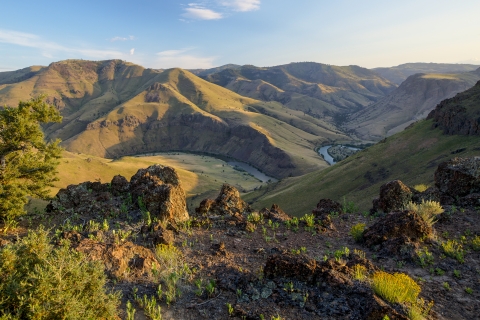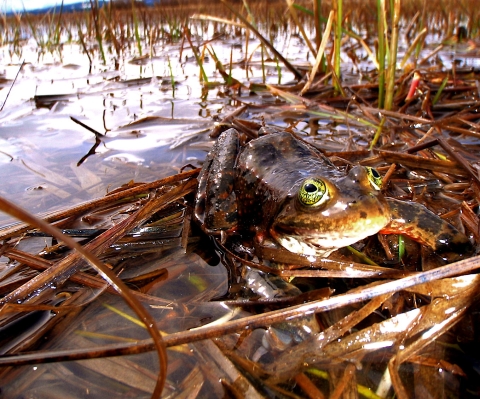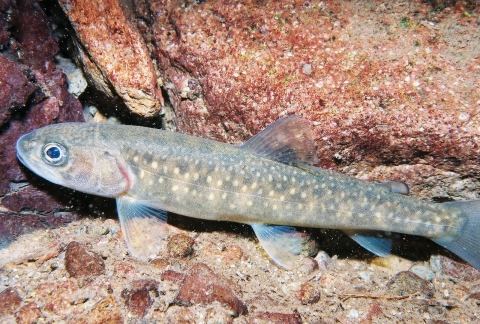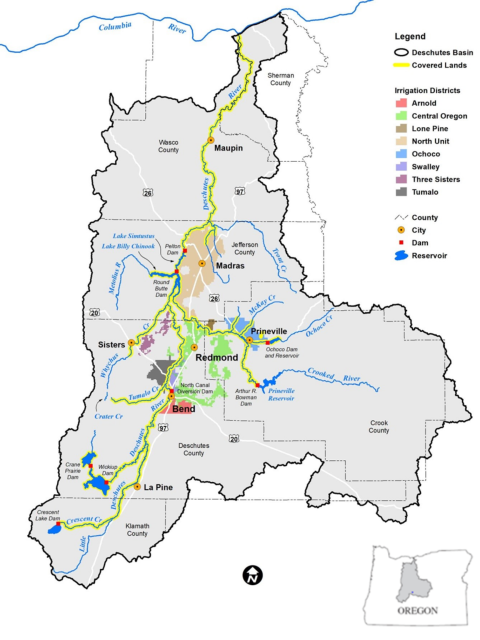The Deschutes River in central Oregon supplies fresh, clean water to people, farms, and wildlife throughout the basin. Although abundant, this precious resource must serve many purposes, including agricultural, environmental, residential, and recreational use. Protecting and managing its water supply is important to the local community, which has come together to assist in developing a durable solution that will provide long-term water certainty.
Water in the Deschutes Basin is now managed, in part, through a Habitat Conservation Plan (HCP). Habitat Conservation Plans are voluntary agreements between the U.S. Fish and Wildlife Service and landowners, private companies, or other non-federal entities that ensure harmful effects of activities (e.g, water management) to threatened and endangered species are avoided, minimized, or offset. The Deschutes Basin HCP is a collaborative strategy to share water resources in the Deschutes Basin, covering irrigation and related water management operations while enhancing fish and wildlife habitat.
The plan encompasses approximately 10,500 square miles. Bounded by the Cascades Mountains on the west, the Ochoco Mountains on the east, and the Columbia River to the north, the Deschutes River Basin includes six major tributaries above Lake Billy Chinook.
Oregon spotted frog and bull trout, both federally-threatened aquatic species, are covered by the U.S. Fish and Wildlife Service in this HCP.
The HCP delivers predictability to water managers by providing certainty on a water storage, release, diversion, and return paradigm for the next 30 years in the Deschutes Basin. It accomplishes this goal through a combination of adjusted water management practices, increased funding for conservation projects and in-stream leasing programs, more gradual ramping up and down of the irrigation season releases, support for on-farm water conservation, maintenance of fish screens, and related items — all to better align the water management operations with the life-history needs of covered species.
The City of Prineville and irrigation district members of the Deschutes Basin Board of Control applied for an Endangered Species Act incidental take permit that authorizes incidental take of listed species caused by covered activities. The term “take” “take”
The term “take” means to harass, harm, pursue, hunt, shoot, wound, kill, trap, capture, or collect, or to attempt to engage in any such conduct.
Learn more about “take” means to harass, harm, pursue, hunt, shoot, wound, kill, trap, capture, or collect, or to attempt to engage in any such conduct.
Conservation measures in the plan are designed to minimize and mitigate potential impacts or the “incidental take” through harm of species covered under this plan that may result from their otherwise-lawful water management activities.
“The HCP will result in long-term benefits to Deschutes River fish and wildlife, the region’s water resources, and provide regulatory certainty for our farmers, ranchers and communities,” said Deschutes Basin Board of Control President Craig Horrell. “To meet the goals and objectives set forth in the HCP, the districts will continue working together to conserve and manage flows for the benefit of the entire community.”
This effort has been a 12-year collaboration among a large group of diverse stakeholders — irrigators, municipalities, recreationists, federal and state agencies, and Tribes.
With a river that serves as the backbone of both our human communities and wildlife species, sustainable water management is a balancing act that has taken years to achieve in the Deschutes River Basin. Years of research and collaboration among managers, biologists, hydrologists and other experts have gone into the effort to ensure critical water needs are met for central Oregonians and our wildlife
“This HCP exemplifies how the agricultural industry, conservation groups, and government successfully work together towards a shared conservation goal,” said Paul Henson, the Service’s Oregon State Supervisor. “The plan provides predictability to water users, durable conservation to aquatic species, and long-term ESA coverage to irrigators.”
Together with partners, and with substantial public involvement, we have achieved a viable solution that will provide long-term water certainty and protect wildlife in the Deschutes Basin. Collaborations like this are the key to successful conservation of our natural resources. It is a plan for both people and wildlife.
Learn more about the Deschutes River Basin in this Story Map or keep up with ongoing updates about the HCP.







